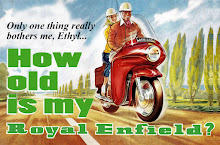 |
The new Royal Enfield Continental GT cafe racer on display at Brooklands.
At rear is the original Royal Enfield Contiental GT of 1964. |
The new Royal Enfield Continental GT cafe racer will cost $7,200 "on the road" when it reaches the U.S., Siddhartha Lal, chairman of parent company Eicher Motors announced Wednesday.
"For the same amount of money you can buy a faster bike," he told a press conference at the historic Brookland race track.
But maybe you don't want to do that, he implied, joking that a member of his team had earned the first speeding ticket for the new motorcycle in a ride to Brighton Tuesday.
"I had wanted to be the one to do that," Lal said.
A sports bike would have guaranteed the CEO a road fine; but that would have been too easy.
On the Continental GT he'd felt more involved, working to get the maximum enjoyment out of the motorcycle.
"Sports bikes can be android like. The machine is bigger than the person. The person is always the limitation, never the machine," he said.
Big cruisers, too, offer effortless power, but can be "intimidating" — if it fell, could you even pick it up?
"There's space for something completely different," Lal said, sounding like the guru of mid-size motorcycles 250-750cc. He means motorcycles where "you don't have excess power and weight."
 |
| CEO Siddhartha Lal tells the press why riders will be drawn to the new cafe racer. |
The Continental GT is "fabulous fun to ride in real-world conditions and allows you to experience the most important time — and that is the present," he said.
Royal Enfield's Unit Constructed Engine has been "sent to the gym" for the Continental GT, adding 35cc and a remapped Electronic Control Unit. The rest of the motorcycle is new from the ground up, with twin downtube frame, new front forks and performance tires and rear shocks.
Obviously, it's also styled to evoke the romantic era of the British cafe racers. Lal explained what he finds so appealing about that period:
"It was a time when people did things."
"The world feels a little flat... virtual and abstract have been taken to their zenith."
iPhone users experience the world in the palm of their hand but "a lot of it is only slabs of glass. What we experience are the experiences of others. We yearn for something more than that. Tactile stuff. We want to create experiences of our own. We want to be in the present."
After the press conference he told a round-table of writers that he wasn't worried that about the Continental GT drawing customers. Its summons to "motorcycling at its absolute purist" will do that, he said.
"There's an affinity. It's somewhere in the back of the mind. If we put it before them it will bring it out," he said.
Specifications released for the Continental GT promise 29.1 bhp. The international journalists present asked why not 10 more? One also got Lal to clarify that the sweet sounding and sexy muffler being displayed on the Continental GT in the UK is an accessory; the standard muffler will be bigger, quieter and presumably less attractive.
But UK distributor for Royal Enfield, Steve Oliver, waved off these concerns when asked about them later, at a launch party at London's Ace Cafe. Prior to the launch he had personally ridden the Continental GT farther than anyone else in the UK. He found it "sublime."
"The power, the brakes, the handling are balanced," he said.













































































